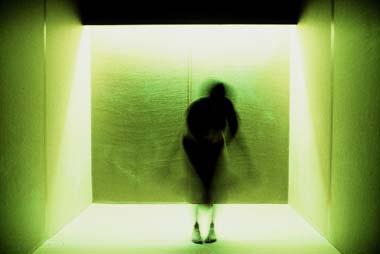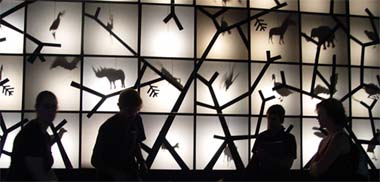During a recent internship at the Portland Institute for Contemporary Art during their Time Based Art festival, Beatrice Whelan has recognised some possibilities for Irish artists, curators and audiences.
When Kristy Edmunds founded PICA (the Portland Institute of Contemporary Art) in 1995, it was after leaving the Portland Art Museum where she was the curator of their Art on the Edge programme. Edmunds saw a potential for presenting experimental art that could not be fulfilled in the confines of the art museum, which was concentrating on acceptable, definable art and commercially viable exhibitions. Ten years on and two years into PICA’s Time Based Art Festival (TBA) , it seems amazing that PICA and even TBA once did not exist. PICA currently has over one thousand members and the TBA festival attracts over 7,500 attendees. Though figures are important, even for a nonprofit like PICA, equally as impressive is the stimulating spirit which pervades through the festival venues during TBA . Also discernable is the feeling of community which filters across PICA all the way from board members and patrons, to staff, sponsors, volunteers and audiences. This network of support and common interest is what best describes PICA, rather than simply an institution of staff and office space.
PICA also differs from other art institutions in that it was not originally founded with the aim of creating an international annual arts festival, such as it now hosts. Originally PICA’s format of art presentation consisted of several series throughout the year, with art presentations, whether visual or performance-based, occurring every few weeks or months, accompanied by residences and other activities. With the conception of the TBA festival, these series are bundled into a ten-day happening, the sum of which in Edmunds’ own words “makes the investment of coming to Portland more viable, while a larger audience size offers a different dynamic where artists can view each other’s work and take part in workshops and noontime chats." [1]
The all-encompassing title and theme of the festival, Time Based Art, includes both recognisable genres and indefinable art pieces, often only united by the fact that they take place within the set time of those ten days. Everything, from theatre, dance, music, film and media combinations, occurs in a variety of locations across Portland city. This offering is further enhanced by lectures, discussions, workshops, and internet blogs.
During TBA, PICA also hosts a nightclub of sorts, created in the shell of a massive 25,000 square-foot warehouse. Machineworks, as it is called, has its own temporary cabaret stage and theatre, and so also acts as one of the many venues for these temporal performances. More than simply a venue, Machineworks itself is also an aesthetic element of the festival, acting as a gathering space for both artists and audiences. [2]
The artists who performed at this year’s festival were local, national and international in origin and reputation. Among them were British duo Lone Twin, American-Greek vocal ‘sensation’ Diamanda Galas and Japanese Butoh master Akira Kasai. Edmunds, now the Artistic Director of TBA (and the Melbourne International Arts Festival 2005 ), says that in considering potential pieces for the festival she is interested in art which offers the possibility of an authentic experience and communicates a universal message. [3]
One of the most authentic experiences of the festival was provided by choreographer Helen Herbertsen and designer Ben Cobham’s Morphia Series. The performance, which traveled to Ireland for the Dublin Fringe Festival in 2003, is extremely intimate, allowing only twelve audience members at a time and so requiring many showings. This piece is thoroughly experiential and sensory. The audience gathers at PICA to be led elsewhere to the performance in an almost somber manner. On entering the building which holds the performance, the audience is cast into complete darkness, unable to sense anything of their surroundings. In pairs we are guided, almost blindly, to our seats in another room, while the remaining audience waits alone in the dark wondering what lies ahead. Then, sitting in a completely darkened room, the audience’s senses become heightened in anticipation. As we question the surrounding space, waiting for our eyes to adjust, the audience cautiously nibbles some polenta topped with passion fruit and a rose petal along with some sweet wine provided while been guided in. When the performance starts in a square frame of light about forty feet from the audience, it seems as if every instant is to be consumed, the clarity provided by the previous minutes of darkness allowing each image to imprint.
As complete darkness hides everything but the frame ahead and two parallel lines running from our seats to the frame, it is as if we sit in a dark rectangular box, a camera obscura, viewing before us something which is real but not real. The silhouette that appears before us moves slowly at first, her limbs seeming to morph into her body. Though this impression changes throughout the course of the performance, her movements becoming almost frantic, every movement, every moment seems essential. Whispers dissolve into sounds conjuring the Australian wilderness. In memory, the performance is just like a dream; the discrete visual imprints are now vague but the experience is vivid and just like all dreams, the experience cannot really be explained. Like the best pieces of performance, this can only be understood by experiencing it, certainly an authentic and intense experience.
Not all of the performances at TBA were as intense as Morphia Series . Some were upliftingly humorous, some required both audiences and artists to allow themselves to become vulnerable, and some of the performances were not for everyone. The festival did provide an indefinable mix, where many different tastes could be satisfied and many avenues for artistic exploration were openp://www.pica.orged. As a result of the authenticity of each performance, no single one is typical of the festival. PICA is already preparing for next year’s festival, which will no doubt be well worth a visit, and its curators are on the lookout for possibilities. Although Ireland has not yet been represented by an artist at TBA, perhaps this could change in 2005.
Beatrice Whelan is an Arts Administrator currently based in Portland, Oregon. [4]
For more information on PICA go to www.pica.org (and also to recirca.com/backissues/c92/portland.shtml ).
Time Based Art Festival, Portland, Oregon, 10 – 19 September 2004





